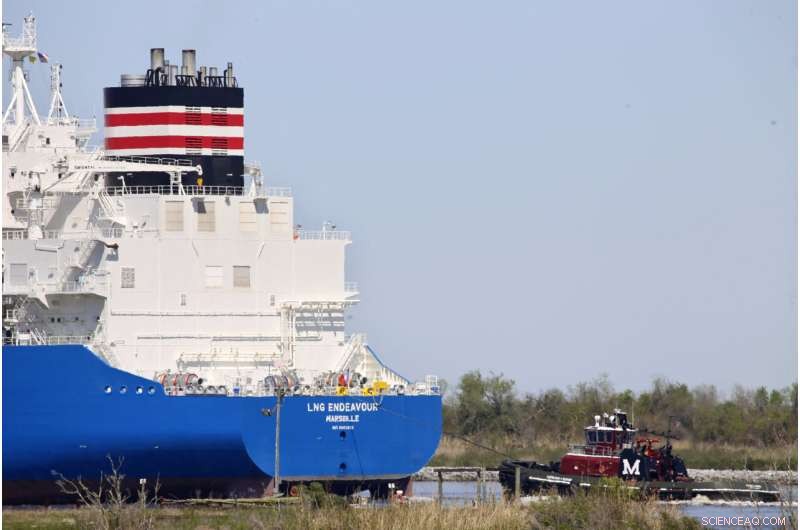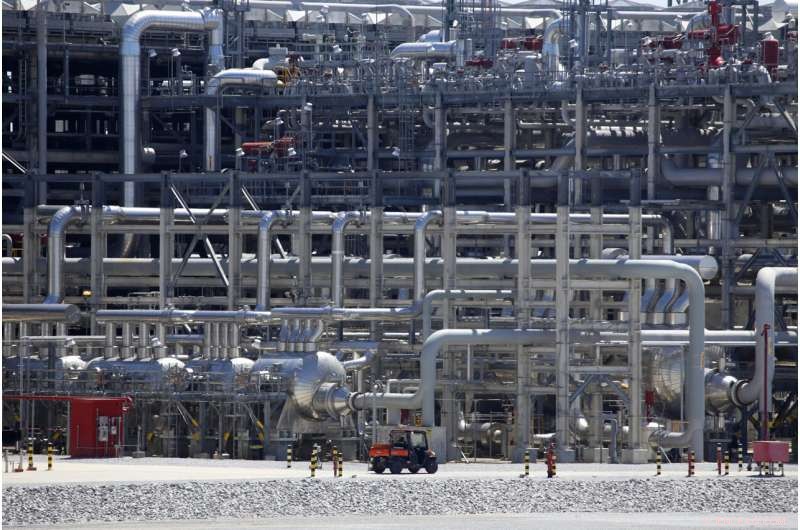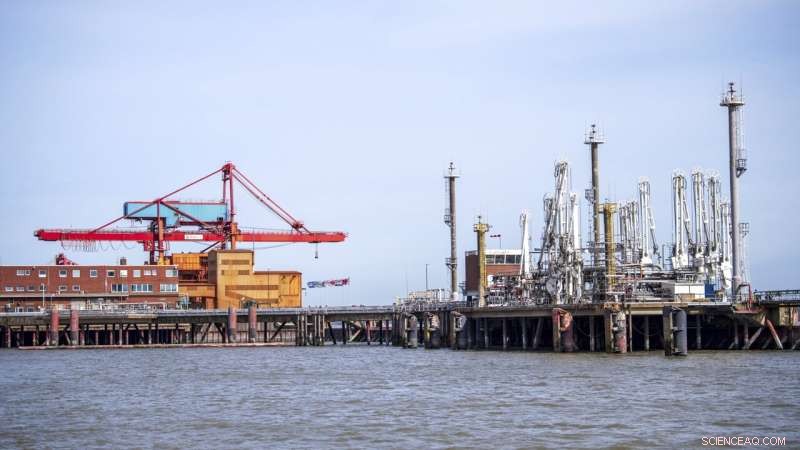
Un remolcador ayuda a guiar un barco francés, conocido como LNG Endeavour, a través del lago Calcasieu cerca de Hackberry, Luisiana, el 31 de marzo de 2022. La guerra de Rusia contra Ucrania destrozó sus relaciones con Europa, que pronto perdió la mayor parte del gas natural que Moscú tenía. proporcionado desde hace mucho tiempo. Ahora, a medida que se acerca el invierno, las naciones europeas han respaldado una solución a corto plazo que comenzará antes de fines de 2022 y que ha despertado las alarmas entre los científicos que temen las consecuencias a largo plazo para el clima. Crédito:AP Photo/Martha Irvine, Archivo
A medida que se acerca el invierno, las naciones europeas, desesperadas por reemplazar el gas natural que una vez le compraron a Rusia, adoptaron una solución a corto plazo:una serie de aproximadamente 20 terminales flotantes que recibirían gas natural licuado de otros países y lo convertirían en combustible para calefacción.
Sin embargo, el plan, con las primeras terminales flotantes preparadas para entregar gas natural a finales de año, ha despertado las alarmas entre los científicos que temen las consecuencias a largo plazo para el medio ambiente. Advierten que estas terminales perpetuarían la dependencia de Europa del gas natural, que libera metano y dióxido de carbono que contribuyen al calentamiento del clima cuando se produce, transporta y quema.
Algunos científicos dicen que les preocupa que las terminales flotantes terminen convirtiéndose en un proveedor a largo plazo de las vastas necesidades energéticas de Europa que podrían durar años, si no décadas. Tal tendencia podría hacer retroceder los esfuerzos de reducción de emisiones que, según los expertos, no se han movido lo suficientemente rápido como para frenar el daño que se está causando al medio ambiente global.
Se espera que gran parte del gas natural licuado, o GNL, que Europa espera recibir provenga de Estados Unidos. La necesidad surgió después de que la invasión rusa de Ucrania rompió sus lazos con Europa y condujo a un corte de la mayor parte del gas natural que Moscú había proporcionado durante mucho tiempo. A lo largo de la Costa del Golfo de EE. UU., las terminales de exportación se están expandiendo y muchos residentes están alarmados por el aumento de la extracción de gas y la consiguiente pérdida de tierras, así como por los cambios climáticos extremos asociados con la quema de combustibles fósiles.
"Construir esta inmensa infraestructura de GNL obligará al mundo a depender de manera continua de los combustibles fósiles y al daño climático continuo durante las próximas décadas", dijo John Sterman, científico climático del Instituto de Tecnología de Massachusetts.
El gas natural contribuye significativamente al cambio climático, tanto cuando se quema, convirtiéndose en dióxido de carbono, como a través de fugas de metano, un gas de efecto invernadero aún más potente. Sin embargo, las naciones europeas, que durante años han sido líderes en el cambio a energías más limpias, han propuesto traer más de 20 terminales flotantes de GNL a sus puertos para ayudar a compensar la pérdida de gas natural de Rusia.
Las terminales, que se elevan sobre las casas y se extienden casi 304 metros (1,000 pies), pueden almacenar aproximadamente 170,000 metros cúbicos (6,000 millones de pies cúbicos) de GNL y convertirlo en gas para hogares y empresas. Se pueden construir de forma más rápida y económica que las terminales de importación en tierra, aunque su funcionamiento es más costoso, según la Unión Internacional del Gas.
"Todos los países deben prepararse para un escenario en el que puede haber un corte en los suministros rusos", dijo Nikoline Bromander, analista de Rystad Energy. "Si eres dependiente, necesitas tener un plan de respaldo".

A flare burns at Venture Global LNG in Cameron, La., on April 21, 2022. Russia’s war against Ukraine shattered its relations with Europe, which soon lost most of the natural gas that Moscow had long provided. Now, as winter nears, European nations have backed a short-term fix set to begin before the end of 2022 that has raised alarms among scientists who fear the long term consequences for the climate.Credit:AP Photo/Martha Irvine, File
Many environmental scientists argue that the money being earmarked for the ships—which cost about $500 million each to build, according to Rystad—would be better spent on rapidly adopting clean-energy or efficiency upgrades that could reduce energy consumption.
Constructing more solar or wind farms, which takes years, wouldn't immediately replace Russian gas. But with adequate funding, Sterman suggested, greater energy efficiencies—in homes, buildings and factories, along with the deployment of wind, solar and other technologies—could vastly reduce Europe's need to replace all the gas it's lost.
Germany, among Europe's strongest advocates for the floating LNG terminals, is expecting five of the ships and has committed roughly 3 billion euros to the effort, according to Global Energy Monitor. Germany has also approved a law to fast-track the terminals' development, suspending the requirement for environmental assessments.
It's a move that troubles environmental groups.
"It's totally obvious," asserted Sascha Müller-Kraenner, CEO of Environmental Action Germany, that "the provisions of the law were developed in close dialogue with the gas industry."
Germany's government and energy industry have defended their embrace of the LNG terminals as an urgent response to the loss of most of the Russian gas they had long received, which they fear Moscow will shut off completely.
"In an exceptional situation such as this, where it's a matter of Germany's gas supply security, it is justified to accelerate the approval process," Germany's energy industry association, BDEW, said in a statement.
Susanne Ungrad, a spokeswoman for Germany's Economy and Energy Ministry, noted that efforts are being made to lower methane emissions in exporting countries like the United States. And she said that in pursuing the construction of LNG terminals, Europe authorities will conduct comprehensive assessments.

A small vehicle drives past a network of piping that makes up pieces of a "train" at Cameron LNG export facility in Hackberry, La., on March 31, 2022. Russia’s war against Ukraine shattered its relations with Europe, which soon lost most of the natural gas that Moscow had long provided. Now, as winter nears, European nations have backed a short-term fix set to begin before the end of 2022 that has raised alarms among scientists who fear the long term consequences for the climate. Crédito:AP Photo/Martha Irvine, Archivo
Greig Aitken, an analyst at Global Energy Monitor, noted that a terminal that's set to open near Gdansk, Poland, has signed contracts with American LNG suppliers that extend well past 2030. That could make it problematic for the European Union to meet its goal of reducing greenhouse gas emissions by at least 55% by 2030.
Italy, Greece, France, the Netherlands, Croatia, Estonia, Finland, Latvia, Slovenia and the U.K. all have one or more floating LNG terminals planned, according to Rystad Energy.
In some cases, proponents argue, the ships could aid the environmental cause. They note, for example, that as Russian gas supplies have dwindled, communities in Germany and elsewhere have been burning coal, which typically produces more emissions than natural gas. Increasing the supply of natural gas would make this less necessary.
Still, methane can frequently leak along the natural gas supply chain. So in some cases, the net climate effect of burning natural gas may be no better than coal.
The U.N. Intergovernmental Panel on Climate Change has warned that continuing to use the fossil fuel infrastructure already in place would cause global warming to exceed 1.5 degrees Celsius (2.7 Fahrenheit). At that level, heat would be expected to worsen the flash floods, extreme heat, intense hurricanes and longer-burning wildfires that have resulted from climate change and have cost lives.
"It is a little disheartening to see Europe, which has been the seat of so much energy and action and bold emissions targets, being home to this particular way with doubling down on fossil fuel infrastructure," said Kim Cobb, a climate scientist at Brown University.
In the United States, the largest export market for Europe-bound LNG, three new export terminals are under construction. Eleven additional terminals and four expansions are in the planning stages. Some export terminals that had struggled to attract financing are now seeing more investment and interest, said Ira Joseph, a longtime energy analyst.
"What you've seen happen over the last two months—they're signing up sales and purchase agreements, right and left," Joseph said.

The area in front of the Stade Industrial Park is part of the future port expansion for the planned import terminal for liquefied natural gas (LNG) in Stade, Germany, on April 2022. Russia’s war against Ukraine shattered its relations with Europe, which soon lost most of the natural gas that Moscow had long provided. Now, as winter nears, European nations have backed a short-term fix set to begin before the end of 2022 that has raised alarms among scientists who fear the long term consequences for the climate. Credit:Sina Schuldt/dpa via AP, File
Rio Grande LNG, an export terminal proposed by Next Decade in Brownsville, Texas, for example, appeared to stall last year in the face of environmental protests. But this spring, a French company, Engie, and several clients in Asia signed long-term contracts to buy LNG from the terminal. Now, Next Decade says it's likely to obtain all the financing it needs.
Europe's gas scarcity has escalated global LNG prices, leading buyers in China and elsewhere to sign long-term contracts with suppliers in the United States. American LNG exports will likely grow by 10 million tons over the next year, said Bromander, the Rystad analyst.
The floating LNG ships have been billed as a short-term solution to keep gas flowing for a few years while cleaner energy sources like wind and solar are built up. But critics say it's unlikely that a ship built to last decades would permanently halt operations after a few years.
Once the floating terminals are built, they can be used anywhere in the world. So if European nations no longer want floating LNG terminals as they transition to cleaner energy, the ships could sail off to another port, essentially locking in the use of natural gas for decades.
And in some cases, particularly in Germany, some of the proposed floating terminals appear to be paving the way for on-shore terminals that would be built to last 30 or 40 years—well past the point that nations should be burning fossil fuels, environmental groups say.
"After the war is resolved and, as we all hope, peace is restored, are they really going to say, 'Oh, let's take it to the scrap yard?,'" Sterman asked. "They're not going to do that."
© 2022 Prensa Asociada. Reservados todos los derechos. Este material no se puede publicar, transmitir, reescribir ni redistribuir sin permiso. EU decision on natural gas could threaten climate progress